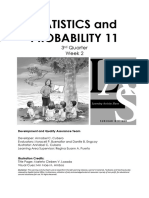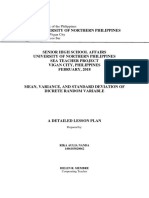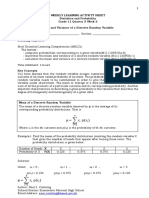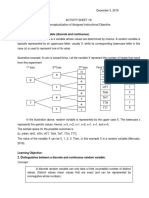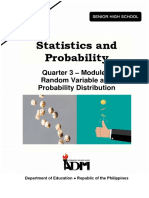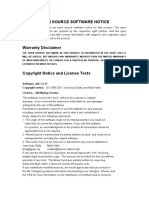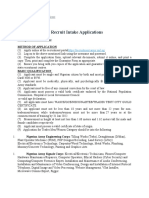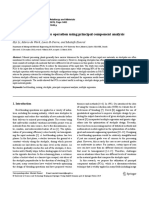Statistics and
Probability
Third Quarter
Module 3:
Mean and Variance of a
Discrete Random Variable
1
� Republic of the Philippines
Department of Education
REGION VII-CENTRAL VISAYAS
SCHOOLS DIVISION OF SIQUIJOR
COPYRIGHT NOTICE
Section 9 of Presidential Decree No. 49 provides:
“No copyright shall subsist in any work of the Government of the Republic of the Philippines.
However, prior approval of the government agency of office wherein the work is created shall be
necessary for exploitation of such work for profit.”
This material has been developed through the initiative of the Curriculum Implementation Division (CID) of
the Department of Education – Siquijor Division.
It can be reproduced for educational purposes and the source must be clearly acknowledged. The material
may be modified for the purpose of translation into another language, but the original work must be acknowledged.
Derivatives of the work including the creation of an edited version, supplementary work or an enhancement of it are
permitted provided that the original work is acknowledged, and the copyright is attributed. No work may be derived
from this material for commercial purposes and profit.
Borrowed materials (i.e. songs, stories, poems, pictures, photos, brand names, trademarks, etc.) included in
this module are owned by their respective copyright holders. Every effort has been exerted to locate and seek
permission to use these materials from their respective copyright owners. The publisher and authors do not
represent nor claim ownership over them.
Published by the Department of Education
OIC-Schools Division Superintendent: Dr. Neri C. Ojastro
Assistant Schools Division Superintendent: Dr. Edmark Ian L. Cabio
Development Team of Learning Module
Writer: Roger Maglangit
Evaluators: Marilou C. Gulahab Mera M. Tuangco
Alma B. Panzo Alberta S. Bato
Management Team: D Dr. Marlou S. Maglinao o
CID - Chief
___________Neddy G. Arong g
Education Program Supervisor (MATHEMATICS)
E Edesa T. Calvadores s
Education Program Supervisor (LRMDS)
Printed in the Philippines
Department of Education – Region VII, Central Visayas, Division of Siquijor
Office Address: Larena, Siquijor
Telephone No.: (035) 377-2034-2038
E-mail Address: deped.siquijor@deped.gov
2
� Statistics and
Probability
Third Quarter
Module 3:
Mean and Variance of a
Discrete Random Variable
3
� INTRODUCTION
This module is written in support of the k to 12 Basic Education
Program to ensure attainment of standards expected of you as a learner.
This aims to equip you with essential knowledge on how to illustrate
and interpret the Mean and Variance of a Discrete Random Variable.
This includes the following activities/tasks:
• Expected Learning Outcome – This lays out the learning outcome
that you are expected to have accomplished at the end of the
module.
• Pre-Test – This determines your prior learning on the particular
lesson you are about to take.
• Discussion of the Lesson – This provides you with the important
knowledge, principles and attitude that will help you meet the
expected learning outcome.
• Learning Activities – These provide you with the application of the
knowledge and principles you have gained from the lesson and
enable you to further enhance your skills as you carry out
prescribed tasks.
• Post-test – This evaluates your overall understanding about the
module.
With the different activities provided in this module, may you find this
material engaging and challenging as it develops your critical thinking skills.
4
� What I Need to Know
At the end of this lesson, you will be able to:
✓ illustrate and interpret the mean and variance of a discrete random
variable.
What I Know
A. Directions: Choose the correct answer of each of the following.
Write the letter of the correct answer in your notebook.
1. What is the sum of the possible outcomes of the experiment multiplied
by their corresponding probabilities in the discrete probability
distribution?
a. mean c. standard deviation
b. variance d. discrete probability distribution
2. What is the amount of spread, dispersion, or variability of the items in
a distribution?
a. mean c. standard deviation
b. variance d. discrete probability distribution
3. What is the other name for the mean of a discrete probability
distribution?
a. mean c. standard deviation
b. variance d. expected value
Given for numbers 4 – 6.
The random variable x represents the number of credit cards
that adults have along with the corresponding probabilities.
x P(x) x ∙ P(x)
0 0.07
1 0.68
2 0.21
3 0.03
4 0.01
4. What is the value of ∑ 𝑷(𝒙)?
a. -1 c. 1.1
b. 1 d. 10
5
�5. What is the mean of the given probability distribution?
a. 0.44 c. 1.23
b. 10 d. 1.32
6. What is the variance of the probability distribution?
a. 0.44 c. 1.23
b. 10 d. 1.32
B. In a pizza takeout restaurant, the following probability distribution
was obtained. The random variable x represents the number of
toppings for a large pizza.
x P(x) x ∙ P(x) x− μ (x − μ)2 (x − μ)2 ∙ P(x)
0 0.30
1 0.40
2 0.20
3 0.06
4 0.04
a. complete the discrete probability distribution.
b. find the mean and variance of the probability distribution.
6
� What’s In
A. The table below shows the result of high school students survey on
the number of pets they have at home.
x Frequency
0 5
1 4
2 6
3 8
4 1
5 1
B. Determine the probability of selecting a student having
1. 3 pets
2. At most 2 pets
3. At least 3 pets
4. At least 1pet
What’s New
Activity: Given the discrete probability distribution for random variable x
representing the number of spots that would appear in rolling a die,
a. Illustrate and interpret the mean number of spots that would
appear.
b. Illustrate and interpret the variance of the probability distribution.
Number of Spots (x) Probability P(x)
1
2
3
4
5
6
7
� What Is It
Mean of a Discrete Probability Distribution
The mean of the discrete random variable can be thought of as
“anticipated” value. It is the average that is expected to be the result when
a random experiment is continually repeated. It is the sum of the possible
outcomes of the experiment multiplied by their corresponding
probabilities. It is also called the expected value of random variable X, and
given a symbol E(X) which is computed using the following formula:
𝝁 = E(X) = x1 P(x1) + x2 P(x2) + x3 P(x3) + …+ xn P(xn)
𝑜r
𝝁 = E( X ) = ∑ 𝒙 𝑷(𝒙)
where:
x1 , x2, x3 , … , xn → discrete random variable
P( x1 ), P( x2 ), P(x3 ), … , P(xn ) → probability of the outcome
μ → mean of the probability distribution
Variance of a Discrete Probability Distribution
The variance of a random variable is defined as the weighted average
of squared deviations of the values of X from the mean, where the weights
are the respective probabilities. It describes the amount of spread,
dispersion, or variability of the items in a distribution.
The variance of a discrete probability distribution is given by the
formula:
𝛔𝟐 = ∑(𝐱 − 𝛍)𝟐 ∙ 𝐏(𝐱)
where:
x → value of the random variable
P(x) → probability of the random variable x
μ → mean of the probability distribution
8
� Note that the standard deviation is the more understandable of the
two measures of spread, since the standard deviation is in the same units as
X and it is the square root of the variance.
𝝈 = √𝛔𝟐 = √∑(𝐱 − 𝛍)𝟐 ∙ 𝐏(𝐱)
Unlike the mean, there is no simple interpretation for the variance or
standard deviation. The variance though is analogous to the moment of
inertia in Physics, but that is not necessarily widely understood by learners.
Stress that, in relative terms,
✓ a small standard deviation (and variance) means that the distribution
of the random variable is quite concentrated around the mean
✓ a large standard deviation (and variance) means that the distribution
is rather spread out, with some chance of observing values at some
distance from the mean
Example:
To learn more on mean and variance of discrete probability
distribution, let us answer the problem given in what’s new.
Given the discrete probability distribution for random variable
representing the number of spots that would appear in rolling a die,
a. Illustrate and interpret the mean number of spots that would appear.
b. Illustrate and interpret the variance of the probability distribution.
Number of Spots (x) Probability P(x)
1 1
or 0.167
6
2 1
or 0.167
6
3 1
or 0.167
6
4 1
or 0.167
6
5 1
or 0.167
6
6 1
or 0.167
6
9
�Solution A:
Step 1. Multiply the value of the random variable X by the
corresponding probability.
Number of Spots Probability
x ∙ P(x)
x P(x)
1 1
1 or 0.167 or 0.167
6 6
1 2
2 or 0.167 or 0.334
6 6
1 3
3 or 0.167 or 0.501
6 6
1 4
4 or 0.167 or 0.668
6 6
1 5
5 or 0.167 or 0.835
6 6
1 6
6 or 0.167 or 1
6 6
Step 2 : Add the results obtained in Step 1.
Number of Spots Probability
x ∙ P(x)
x P(x)
1 1
1 or 0.167 or 0.167
6 6
1 2
2 or 0.167 or 0.334
6 6
1 3
3 or 0.167 or 0.501
6 6
1 4
4 or 0.167 or 0.668
6 6
1 5
5 or 0.167 or 0.835
6 6
1 6
6 or 0.167 or 1
6 6
21
Mean = 𝜇 = ∑ 𝑥 ∙ 𝑃(𝑥) = = 3.5
6
Interpretation:
The mean tells us the average number of spots that would appear in a
roll of die. So, the average number of spots that would appear is 3.5.
Although the die will never show a number, which is 3.5, this implies that
rolling the die many times, the theoretical mean would be 3.5.
10
�Solution B:
Step 3. Subtract the mean from each value of the random variable X.
Number of Spots Probability
x ∙ P(x) 𝐱− 𝛍
x P(x)
1 1
1 or 0.167 or 0.167 1 – 3.5 = -2.5
6 6
1 2
2 or 0.167 or 0.334 2 – 3.5 = -1.5
6 6
1 3
3 or 0.167 or 0.501 3 – 3.5 = -0.5
6 6
1 4
4 or 0.167 or 0.668 4 - 3.5 = 0.5
6 6
1 5
5 or 0.167 or 0.835 5 - 3.5 = 1.5
6 6
1 6
6 or 0.167 or 1 6 - 3.5 = 2. 5
6 6
Step 4. Square the results obtained in Step 3.
Number of Spots Probability
x ∙ P(x) 𝐱− 𝛍 (𝐱 − 𝛍)2
x P(x)
1 1
1 or 0.167 or 0.167 -2.5 6. 25
6 6
1 2
2 or 0.167 or 0.334 -1.5 2. 25
6 6
1 3
3 or 0.167 or 0.501 -0.5 0. 25
6 6
1 4
4 or 0.167 or 0.668 0.5 0. 25
6 6
1 5
5 or 0.167 or 0.835 1.5 2. 25
6 6
1 6
6 or 0.167 or 1 2. 5 6. 25
6 6
Step 5: Multiply the results obtained in Step 3 by the corresponding
probability.
Number of Probability
x ∙ P(x) 𝐱− 𝛍 (𝐱 − 𝛍)2 (𝐱 − 𝛍)𝟐 ∙ 𝐏(𝐱)
Spots (x) P(x)
1 1
1 or 0.167 or 0.167 -2.5 6. 25 1.04375
6 6
1 2
2 or 0.167 or 0.334 -1.5 2. 25 0.37575
6 6
1 3
3 or 0.167 or 0.501 -0.5 0. 25 0.04175
6 6
1 4
4 or 0.167 or 0.668 0.5 0. 25 0.04175
6 6
1 5
5 or 0.167 or 0.835 1.5 2. 25 1.04375
6 6
1 6
6 or 0.167 or 1 2. 5 6. 25 0.37575
6 6
11
� Step 6 : Get the sum of the results obtained in Step 5.
Number
Probability (𝐱 − 𝛍)2 (𝐱 − 𝛍)𝟐 ∙ 𝐏(𝐱)
of Spots x ∙ P(x) 𝐱− 𝛍
P(x)
x
1 1
1 or 0.167 or 0.167 -2.5 6. 25 1.04375
6 6
1 2
2 or 0.167 or 0.334 -1.5 2. 25 0.37575
6 6
1 3
3 or 0.167 or 0.501 -0.5 0. 25 0.04175
6 6
1 4
4 or 0.167 or 0.668 0.5 0. 25 0.04175
6 6
1 5
5 or 0.167 or 0.835 1.5 2. 25 1.04375
6 6
1 6
6 or 0.167 or 1 2. 5 6. 25 0.37575
6 6
Variance = σ2 = ∑(X − μ)2 ∙ P(x) = 2. 9225 or 2.92
Interpretation:
Since it has a small variance which 2.92 so it means that the
distribution of the random variable is quite concentrated around the mean.
What’s More
Activity: Answer the problem below. Show your solutions in your
notebook.
The officers of EVNHS Class 71 decided to conduct a lottery for the
benefit of the less privileged students of their alma mater. Two hundred
tickets will be sold. One ticket will win Php 5, 000 price and the other
tickets will win nothing. If you will buy one ticket, what will be your
expected gain?
To answer the problem, follow the steps below and complete the table.
Step 1. Find the probability of losing.
Step 2. Find the probability of winning.
Step 3. Find the mean or expected value.
x P(x) xP(x)
0
Php 5, 000
Mean = 𝜇 = ∑ 𝑥 ∙ 𝑃 (𝑥 ) =
12
� What I Have Learned
I learned that:
the mean (or expected value) of a discrete random variable, say X, is a
weighted average of the possible values of the random variable, where
the weights are the respective probabilities
the variance is the expected value of the squared deviations from the
mean.
What I Can Do
Activity: The random variable x represents the number of tests that patient
entering a hospital will have along with the corresponding
probabilities. Complete the table below to illustrate the mean and
variance. Write your answers in your notebook.
x P(x) x ∙ P(x) 𝐱− 𝛍 (𝐱 − 𝛍)2 (𝐱 − 𝛍)𝟐 ∙ 𝐏(𝐱)
0 0.20
1 0.40
2 0.30
3 0.08
4 0.02
a) Find the mean
b) Find the variance
13
� Assessment
Directions: Complete the table below to illustrate the mean and variance.
One point for every missing value. Interpret also the mean and
variance.
Given: In a recent little league softball game, each player went to bat 4
times. The number of hits made by each player is described by
the following probability distribution.
Number Probability
x ∙ P(x) 𝐱− 𝛍 (𝐱 − 𝛍)2 (𝐱 − 𝛍)𝟐 ∙ 𝐏(𝐱)
of hits (x) P(x)
0 0.10
1 0.20
2 0.30
3 025
4 0.15
Interpretation: _____________________________________________________
14
� References
Commission on Higher Education, Teaching Guide for Senior High
School Probability and Statistics Finding the Mean and Variance. First
Edition 2016.
https://www.google.com/search?q=mean+and+variance+of+discrete+random
+variable&source=lnms&tbm=isch&sa=X&ved=2ahUKEwjFk9X9_NPtAhWyxY
sBHanSBG0Q_AUoAXoECAUQAw&biw=1366&bih=625#imgrc=VB8GntCengE
dHM
15











